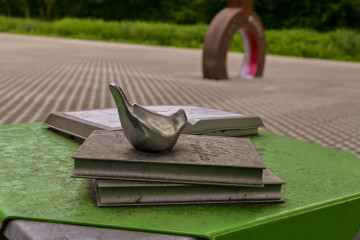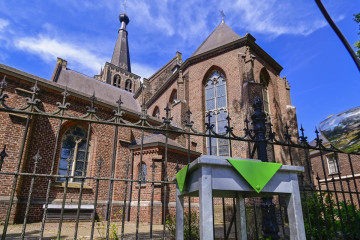
Poem tables
At as many as 20 locations in municipality Heeze-Leende you will find poetry tables.
At as many as 20 locations in municipality Heeze-Leende you will find poetry tables. On each table are two poems, appropriate to the location; one by an adult and one by a child. This provides space for masterpieces and adds an extra dimension to the already beautiful surroundings. There are several cycling and walking routes that take you past these poetry tables and other masterpieces in Heeze-Leende.
Do the poetry route on foot or by bike
You can admire poems in Heeze, Leende, Leenderstrijp and Sterksel during the marked walking and cycling routes of various distances. The walking routes start at the town hall in Heeze, 't Brouwershuis in Leende and the Spar in Sterksel. The routes range in distance from 6.5 kilometers to 10.3 kilometers. The bicycle route is 28 kilometers long and starts at the town hall in Heeze. Of course you can start a route at any other point as they run via the junctions.
View routesLocations

Brewery Leende
'T Brouwershuis was founded by the Maas family as brewery De Zwaan (Swaen). Last century it was changed to 't Brouwershuis. The original logo can still be seen in the facade. The monumental building is now used as a restaurant and occupied by an assisted living group. At the corner of Oostrikkerstraat is a crucifix erected in 1930 and maintained by the neighborhood community.

De Oude Baan
This table stands at the end of the hamlet of De Heezerenbosch. Formerly the Oude Baan was called the Dreef. In the time of the carriages it was the connecting road between Heeze and Valkenswaard with the Heezerhut as a stopping place.
The Heezerbosch still has some beautiful long-fronted farmhouses and is popular with cyclists, hikers and holiday makers because of its beautiful nature both left and right of the Oude Baan.

De Plaetse
Natuurpoort De Plaetse is the starting point for a walk or bike ride through the Strabrechtse Heide; an immense heathland with numerous fens, forests and shifting sands. Near the Plaetse is the sheepfold, which houses a flock of 350 Kempen heath sheep. Enjoy a drink or lunch at Heidecafé de Strabrechtse Heide and discover the heather garden, beehives and insect hotel.

Vlaamseweg exit Lange Bleek
Located on the forest road to the former country house of the fam Eliens from Einhoven. This family had a villa at the Bultven as a country house. Commandeered by the SS during World War II set on fire by the resistance. Remains are still visible in the forest area. Now highlanders, ponies and sheep graze in this bird-rich area. There is also a monument to three Dutch soldiers killed on this moorland on May 12, 1940.

Town Hall in Heeze
Around this Poetry Table are as many as 5 buildings of historical value and are therefore a municipal monument;
Schoolstraat 2 : old public elementary school, now furnished as office space by local entrepreneurs.
Kapelstraat 120; mansion from the fourth quarter of the 19th century
Kapelstraat 116; Villa Mari-Louise from 1st quarter 20th century with characteristics of neo-renaissance style. It was built for yarn ribbon and tape manufacturer Anna Vullinghs
Kapelstraat 81; house of 1870 former horse tram stop of Heeze
Jan Deckersstraat 9-11 Former residence principal Jan Deckers built at the end of the 19th century.

Tapperij de Zwaan
Near this table you can see two more houses with the characteristic red/white shutters. The red/white shutters indicate that these properties are owned by Castle Heeze. One property is a former farm which is now in use as a residence, retail wine shop and a hall complex upstairs in the former hayloft.
The pigsty next to the property is in use as a restaurant. The second building across the street is a residential house which was formerly occupied by a worker at the castle.
The Protestant church was built in 1906 and stands where the medieval chapel of the castle used to be. The church still has a chime with a bell from 1451 made by Jan van Asten with the inscription "Vocor Maria 1451". Opposite the Protestant church is cafe "De Zwaan". In this cafe, which every Heezenaar knows, the gentlemen Jo Paans, Willie van Kemenade and Marcel van der Heijden brought the Brabantsedag to life in 1957. A theater parade which nowadays has grown into a large cultural spectacle and which attracts tens of thousands of people from far and wide. Along the cafe is the driveway to the castle with its beautiful fencing and a beautiful dovecote at the entrance.

Kapellerput estate
Kapellerput was built in 1956. Designed by architect de Bever on behalf of the Order of Jesuits, who that same year put this building into use as a retreat house for R.C. boys who were going to do their military service. It is now used as a conference hotel.
Kapellerput derives its name from a legend of the chapel that would have stood in the fens in front. The legend of Black Narob a robber knight and his good Wife Euvelwinde. The table also serves as a starting point during Kunstsmullen, an event held every year in October. The route with six tables takes you to galleries and works of art.

Heezerhut
Heezerhut was in the 17th century a hub for stagecoaches, both the stagecoach from Eindhoven to Hamont, and the stagecoach from Heeze to Valkenswaard had their transfer point cq resting point there. In the last century destroyed by fire. Now back in use as a house.

Cooperatie Sint Jan Leenderstrijp
A nostalgic grocery store in a modern twist: Coop Sint Jan is a nostalgic grocery store with a modern assortment. It is the oldest independent grocery store in the Netherlands. The store was founded in 1916 by the inhabitants of Leenderstrijp with the aim of funding their own elementary school. Here it still exists that customers buy a booklet on credit. The old cozy atmosphere of yesteryear is still there. In several places around Coop St Jan there are still beautiful old long-gabled farmhouses.

Kloostervelden
The poetry table stands on the grounds of the former Provendentia, part of Kempenhaeghe. For several years patients with epilepsy lived on this site, permanently hospitalized in buildings with their own room, restaurant and theater.
Since a few years these patients are integrated in a new residential area the Kloostervelden which is still under development. They have their own workshop "Kempro" and assist in the restaurant "De Broeders". The site also features the former monastery with its attached chapel. Within the cemetery of the monastery in its own section are buried 42 British soldiers who died in the Second World War.

Sint-Petrus’-Bandenkerk
The Lindse Blaos is known far and wide. In the center of Leende stands the beautiful late Gothic Sint Petrus' Banden church with the special built-in knob tower. This medieval church is considered by connoisseurs to be one of the most beautiful in the area. The tower is crowned with a bladed sphere popularly called the "Lindse Blaos. This characteristic image is visible from afar.

Bels Lijntje Huisvenseweg
On the Sandermannen in the last century, there was a wooden fire tower with the forester's house nearby, in which for years the forester van Dael lived with his wife and son. The wooden tower was replaced by a steel tower. It was demolished together with the forester's house in the 1970s. The entire forest complex is now a water catchment area of Brabant Water. This company also maintains the fens.
Where the bicycle path from Geldrop to Valkenswaard now runs, the railroad line Geldrop-Valkenswaard-Achel used to run. The railroad line was built because the then mayor of Waalre did not allow a railroad line (Eindhoven-Achel) under his window.

Nicasiuskapel, Kreijl
Nicasius of Heeze was one of the martyrs of Gorichem (Gorcum). He was beatified 1675 and canonized in 1867. The chapel was built after World War II on the initiative of local residents and is said to stand on the birthplace of St. Nicasius. The St Nicasius Chapel is maintained by local residents.

Before viaduct Heezerenbosch over the A2
Enjoy the beautiful Heath landscape with the deep lakeven and dry lakeven. With many shifting dunes. On the other side of the A2 is a developing heathland area with some beautiful fens after a large fire in 1979. Along the Oude Baan you can still find two monumental Scots pines.

NS train station
Heeze Station was built on part of what used to be called the Laarstukken. It came in place of the old station at the Oude Statiosnstraat/ Leenderweg. This was because the development of the Nieuwe Hoeve residential area created a need for a station that would be more centrally located in the village.

Herbertusbossen, Boschlaan
Here you are at the beginning of an English garden which was created in the early 20th century and is now known as the Herbertusbossen. The garden was laid out on the lower part of the heathland between Kleine Dommelen Somerenseweg and bisected by the Sterkselse Aa. The beautiful home for the gamekeeper was Jagerslust and diagonally opposite two farms with two dwellings each that served as homes for forest workers and farmers in the service of the castle. Today the Herbertus woods are owned by the Brabantslandschap.

Molenberg
Here you will find the entrance to the Leenderbos with many shifting sand dunes. It was built in the early 1930s as a job center for the many unemployed and also for the mining wood from the pines, which was intended for the mines in Limburg. Remains of the mill of Leende that stood here are still visible.

Sint Janskapel
In the 15th century there was a larger chapel on this site. This one was not inferior to most churches. It was dedicated to St. John the Baptist. After 1648 the chapel fell into disrepair because the Catholic faith was forbidden. Catholic churches and chapels were closed as a result of the Peace of Münster. People worshipped since then in sheltered churches or chapels located just across the border. Around 1840 there was religious freedom again and the ruins of the chapel were cleared away. A new chapel was built on the site of the ruin in 1843.
The mound was created because the remains of the previous chapel are still here, and because subsequently the area was de-sanded. In 1973 and 1999, the chapel was restored.

D’n Os
The church in Sterksel was consecrated by Bishop Diepen on May 21, 1928 in honor of St. Catherine in memory of the medieval chapel. Relics of the Roman martyrs Eustachius and Maximianus were placed in the altar.
The ox commemorates the 14 oxen used during the reclamation of Sterksel. It was intended as a joke this statue but is today embraced by the local carnival association. It also plays a role when a young man is still single at age 30, then a party is built around the ox and the "victim.

Smalspoorlijntje
The start of Sterksel: After 1900 the reclamation of the village of Sterksel began. For this purpose, at that time NV "de Heerlijkheid Sterksel" built a narrow gauge railway of four kilometers long with a station. In memory of this, there is a monument consisting of a fifteen-meter-long track with an information board. In May 2006, the shortest railroad in the Netherlands was opened by Mayor Paul Verhoeven of the municipality of Heeze-Leende.



